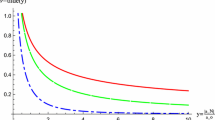Abstract
A massless Weyl-invariant dynamics of a scalar, a Dirac spinor, and electromagnetic fields is formulated in a Weyl space, W4, allowing for conformal rescalings of the metric and of all fields with nontrivial Weyl weight together with the associated transformations of the Weyl vector fields κμ, representing the D(1) gauge fields, with D(1) denoting the dilatation group. To study the appearance of nonzero masses in the theory the Weyl symmetry is broken explicitly and the corresponding reduction of the Weyl space W4 to a pseudo-Riemannian space V4 is investigated assuming the breaking to be determined by an expression involving the curvature scalar R of the W4 and the mass of the scalar, selfinteracting field. Thereby also the spinor field acquires a mass proportional to the modulus Φ of the scalar field in a Higgs-type mechanism formulated here in a Weyl-geometric setting with Φ providing a potential for the Weyl vector fields κμ. After the Weyl-symmetry breaking, one obtains generally covariant and U(1) gauge covariant field equations coupled to the metric of the underlying V4. This metric is determined by Einstein's equations, with a gravitational coupling constant depending on Φ, coupled to the energy momentum tensors of the now massive fields involved together with the (massless) radiation fields.
Similar content being viewed by others
REFERENCES
H. Weyl, Gravitation und Elektrizität (Sitzungsber. Preuss. Akad. Wiss., 1918), pp. 465–480; Ann. Phys. (Leipzig ) 59, 101-133 (1919).
H. Weyl, Raum-Zeit-Materie, 7th ed. (Springer, Heidelberg, 1988). Compare also Z. Phys. 56, 330–352 (1929).
T. Fulton, F. Rohrlich, and L. Witten, Rev. Mod. Phys. 34, 442–457 (1962).
H. Tann, Einbettung der Quantentheorie eines Skalarfeldes in eine Weyl-Geometrie—Weyl-Symmetrie und ihre Brechung, Dissertation (Fakultät fü r Physik der Ludwig-Maximilians-Universität München, München, Apr. 1997) (published by Herbert Utz Verlag, München, 1998; ISBN: 3-89675-318-5).
C. G. Callan, S. Coleman, and R. Rackiw, Ann. Phys. (N.Y.) 59, 42–73 (1970).
A. Trautman, personal communication. See also M. Cahen, S. Gutt, and A. Trautman, J. Geom. Phys. 10, 127–154 (1993)
R. Penrose, Proc. Roy. Soc. (London ) 284, 159–203 (1965).
W. Pauli, Herv. Phys. Acta. 13, 204–208 (1940).
E. Schrödinger, Diracsches Elektron in Schwerefeld I (Sitzungsber. Preuss. Akad. Wiss.,1932), pp. 105–128.
F. Rohrlich, Classical Charged Particles (Addison-Wesley, Redwood City, 1965).
S. Helgason, The Radon Transform (Birkhäuser, Basel, 1980), p. 144.
W. Drechsler, Mass-Generation by Weyl-Symmetry Breaking, MPI-PhT/98-68.
W. Drechsler, Math. Phys. 38, 5531–5558 (1997).
W. Drechsler and D. Hartley, J. Math. Phys. 35, 3571–3586 (1994).
S. Kobayashi and K. Nomizu, Foundations of Differential Geometry, Vol. 1 (Interscience, Wiley, New York, 1963), pp. 57 and 88.
E. Cartan, Ann. Ec. Norm. Sup. 39, 325–412 (1922);41, 1-25 (1924); 42, 17-88 (1925).
R. Bach, Math. Z. 9, 110–135 (1921).
S. S. Chern, Ann. Math. 45, 747–752 (1944); Ann. Math. 46, 674-684 (1945).
W. Drechsler, GRG 15, 703–723 (1983).
Rights and permissions
About this article
Cite this article
Drechsler, W., Tann, H. Broken Weyl Invariance and the Origin of Mass. Foundations of Physics 29, 1023–1064 (1999). https://doi.org/10.1023/A:1012851715278
Issue Date:
DOI: https://doi.org/10.1023/A:1012851715278



